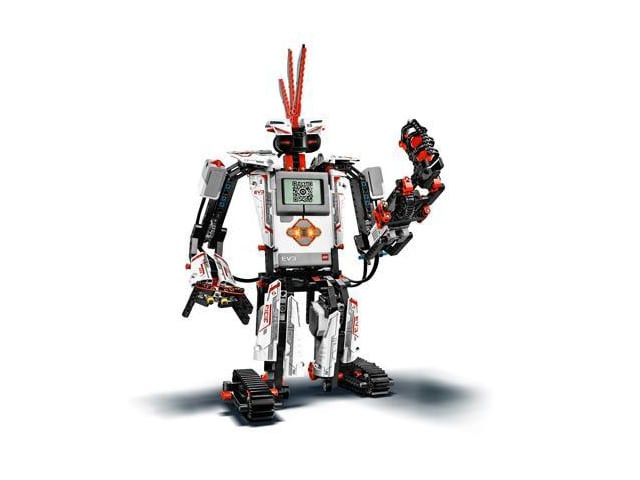Riding with robots
Students build, code and solve, one Lego brick at a time.

File photo of a Lego robot. PHOTO: EXPRESS/FILE
Members from the opposing team, the “Aftershocks,” also line up on the opposite side of the table. Then judges begin the countdown: “Ready, get set, go!”
This is the First Lego League (FLL), an annual international event that’s come to Pakistan for the first time. Sponsored by the Education Enrichment Foundation, STARfALL and Robotics Lab, regional events in Karachi, Lahore and Islamabad will be followed by a national event to qualify a team for the final showdown in the US The idea behind FLL is to create awareness amongst children regarding science and technology and help them develop an interest in fields like engineering and computer science.

The Electrolytes, Aftershocks and six other teams have been working on their Lego-bots for two months; creating, experimenting, testing and improving them. They have taken them apart and put them back together countless times. Their task: to create and programme a robot that can autonomously navigate an obstacle course and score as many points as possible within a two and a half minute time period. It is a difficult endeavour, especially since the participants are all between the ages of 9 to 16.
The competition format itself is fairly straightforward: Each team gets four tries to score as many points as they can — one practice run and three rounds that count. In FLL, only your highest score gets counted; the other two and the practice round get thrown out. The robots operate autonomously on the course for the most part: The kids programme the robot to move around the course along a particular path, so once the robot leaves its base it’s on its own. The robots have to complete a number of tasks that include lifting weights, ferrying balls from one end of the course to the other and even bowling.
Some of the teams keep it simple and use the least amount of attachments to keep their robot uncomplicated and easy to handle while others have created complex robots. Team Sparks, for example, added a third wheel to their robot to help it manoeuvre while Team LegoCore added colour sensors to help their robot to distinguish between different coloured bottles and pick the right one!
It is overwhelming to see such young children so at ease with robots and complicated computer programming. I watch in amazement as Shahab explains to the judge about the programming they used and can’t help but smile when his teammates attempt to explain the challenges they faced; from conflict resolution to maintaining ethics and discipline.”I found this event to be really interesting as it helped me learn about computer programming and robotics,” says Shahab.

And it’s not just the boys but girls are also in on the fun. One of the team leaders, Aqdas Fatima, admits to having been clueless about robotics till two months back, when her team started taking classes at the Robotics Lab to learn programming for the competition. “The event has been a great experience; preparing for it has been exhausting but it has really helped me to learn how to cope with pressure,” she says.
The energy emanating from these children is contagious as they run around with their team mates, and even the judges’ rooms are abuzz with excitement. Distinguished personalities from the fields of computer science and technology sit in rows, watching the demonstrations taking place in front of them. “These children are brilliant! They have so many different types of solutions for each problem they encounter. FLL is a great experience and I wish more children would participate,” says Shoaib Zaidi, Dean of NED University.
Racing robots may seem like the biggest part of this competition, but in reality there’s a lot more to it. The children are also given a real world problem that they have to find a solution to.
The second competition is called Senior Solutions, in which the teams had to come up with an innovative idea for a device that would help senior citizens maintain their independence. The variety of solutions that the children came up with is inspiring. The best one was in the form of a skit that was playful but had a strong message. A grandson presents a watch to his grandfather who initially refuses to accept it but eventually concedes upon his insistence. The watch can record ones heart rate and contacts an emergency line in case of an irregularity. Later on in the day, the grandfather actually has a heart attack but lives through it, thanks to the watch that was ‘smart’ enough to call an ambulance to the spot! When one of the judges tells the boy that such a band actually exists, the boy quips, “but does it also tell time?”
A major component of FLL is its core values, which emphasise teamwork, friendly competition, discovery, creativity, and, well, fun—these are Lego robots, after all! Participants have to provide examples of values that they have developed and practiced since they started working together as a team.
As a society we tend to be oblivious to a very important discipline — Science. This is a dangerous trend, and while children in developed countries are a lot more aware of how technology works and influences our lives, our children didn’t really have a platform to explore science. At least, not until the robotics lab came around!
Published in The Express Tribune, Sunday Magazine, January 27th, 2013.
Like Express Tribune Magazine on Facebook to stay informed and join the conversation.



















COMMENTS
Comments are moderated and generally will be posted if they are on-topic and not abusive.
For more information, please see our Comments FAQ